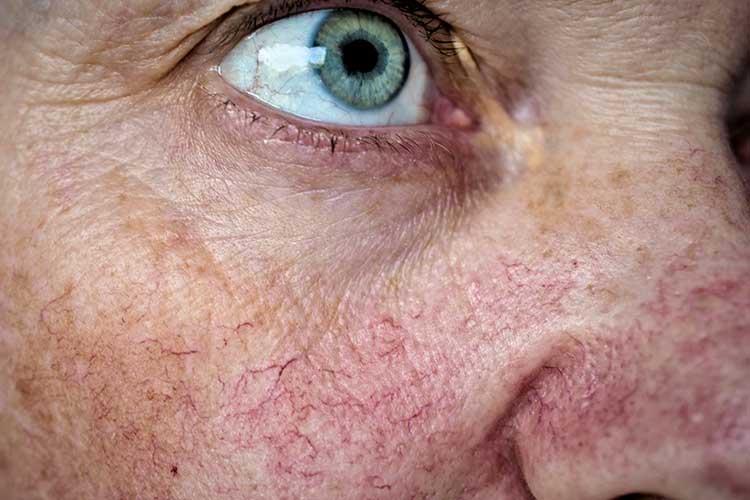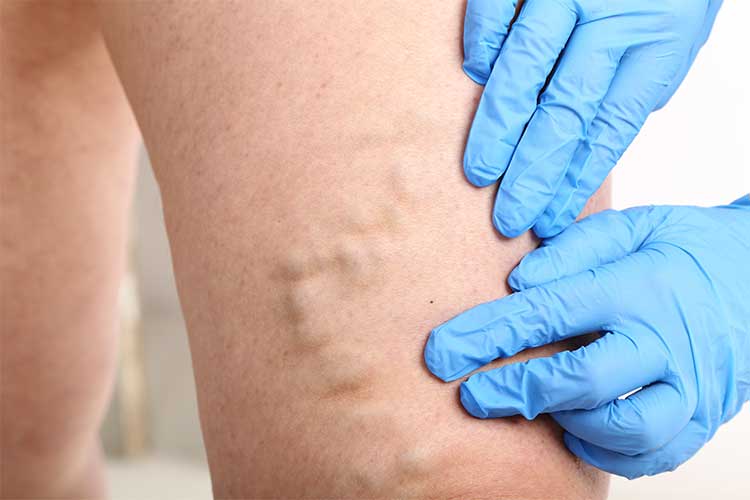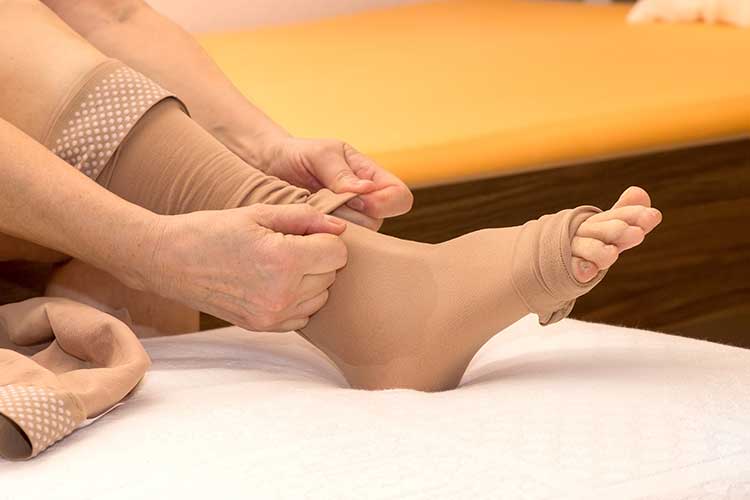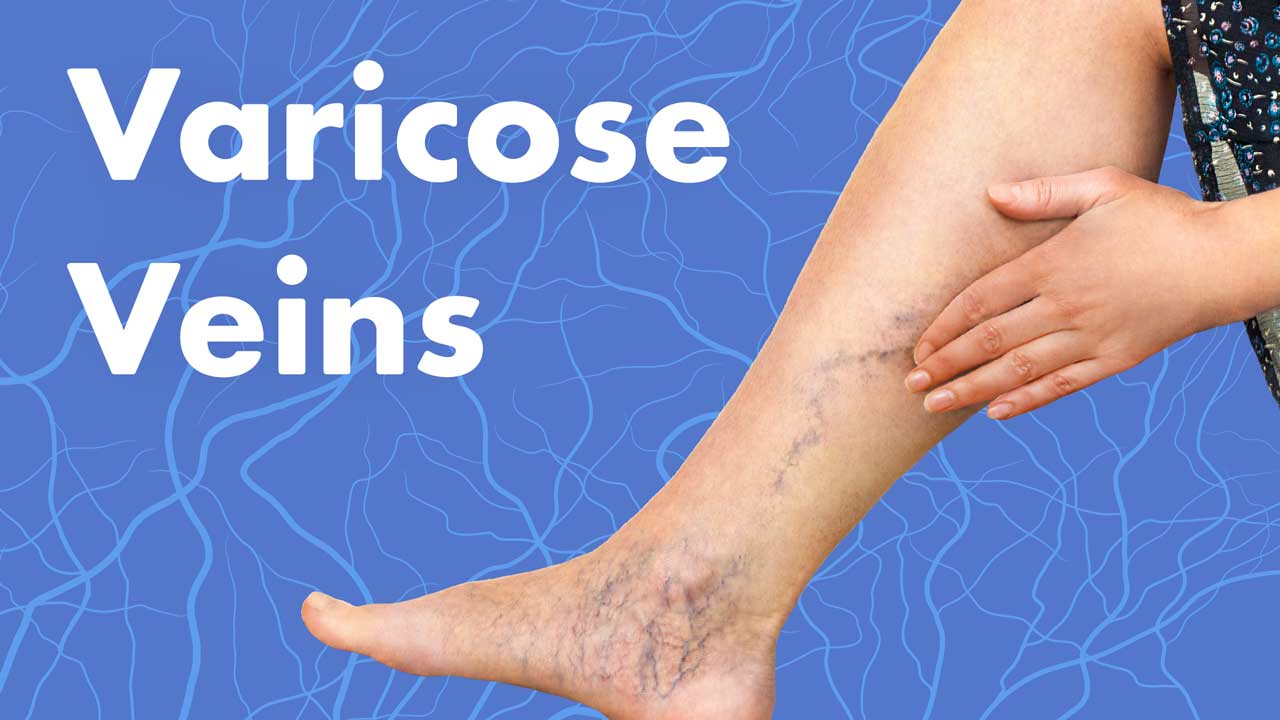Varicose veins are swollen, twisted, blue-in-colour blood vessels under the skin. They most commonly occur in the legs and feet (Better Health Channel 2024).
Veins have one-way valves inside of them that open and close to keep blood flowing towards the heart. When weakened or damaged, valves or walls in the vein cause blood to pool or flow backward (reflux). Varicose veins occur when these veins grow larger and become distorted due to blood pooling (NHLBI 2023; Better Health Channel 2024).
Note that while they mainly appear in the legs, varicose veins can also occur in the:
- Rectum (haemorrhoids)
- Scrotum (varicoceles)
- Oesophagus (oesophageal varices).
(NHLBI 2023; Mayo Clinic 2023)
Spider Veins
Closely associated with varicose veins are ‘spider veins’, which occur when blood that collects in varicose veins leaks into smaller blood vessels (capillaries) and enlarges them. Spider veins are smaller and closer to the surface of the skin. They are often found on the face or legs (Healthdirect 2022; Better Health Channel 2024).

Why are Varicose Veins Most Common in the Legs?
The veins in the legs are further away from the heart. Therefore, blood is working against gravity for a long distance, making it more difficult for blood to flow upwards (OASH 2021).
Risk Factors for Varicose Veins
Women are twice as likely to get varicose veins as men, possibly because female hormones might cause the veins to dilate. If this is the case, birth control pills or hormone therapy could contribute to the likelihood of developing varicose veins (Brazier 2023).
Other risk factors include:
- Pregnancy
- Menopause
- Having a family history of varicose veins
- Being over 50
- Obesity
- Standing for long periods of time.
(Brazier 2023)
Symptoms of Varicose Veins
- Bulging, bluish veins
- Aching, throbbing or burning leg pain
- Itchy, heavy, cramping or restless legs
- Swollen ankles
- Darkened skin
- Venous eczema.
(Healthdirect 2022; Better Health Channel 2024)
Complications of Varicose Veins
Any situation where blood flow is restricted or undermined is cause for concern. While most varicose veins cause no complications, potential issues include:
- Bleeding from the affected vein
- Venous ulcers
- Poor circulation
- Thrombophlebitis (blood clots that cause inflammation)
- Deep vein thrombosis (DVT).
(Brazier 2023; Healthdirect 2022)
Note that bleeding from varicose veins is considered a medical emergency (NHLBI 2023).
Diagnosing Varicose Veins

To diagnose varicose veins, a general practitioner (GP) will perform a physical examination and request the following information:
- Symptoms
- Family history
- Activity levels
- Lifestyle.
(NHLBI 2023)
A GP might assess the health of the leg veins using ultrasound or other imaging tests such as an X-ray or computed tomography (CT) scan (NHLBI 2023).
Treatment for Varicose Veins
Treatment options range from conservative to surgical approaches. Varicose veins may worsen without treatment (Healthdirect 2022; Antani & Dattilo 2023).
Treatment options include:
- Conservative treatments, including long-term compression stocking use, leg elevation, and oral analgesics.
- Sclerotherapy: Involves injecting medication to seal or close veins. Complications may include changes to skin colour and, in rare cases, venous thromboembolism, nerve damage, or allergic reaction.
- Endovenous ablation: Uses lasers or radiofrequency energy to seal the appropriate vein. Complications include bruising, pain, and changes in skin colour. Serious complications including numbness, venous thromboembolism, and skin burns can occur but are uncommon.
- Phlebectomy: Removes small veins.
- Surgical treatments.
(Antani & Dattilo 2023; NHLBI 2023)
The aim of treatment is to relieve symptoms, improve cosmetic appearance, and prevent complications such as serious skin ulcers or sores, DVT, skin colour changes, and bleeding (NHLBI 2023).
Preventing Varicose Veins

While it is not entirely within a person’s control to prevent varicose veins, the following actions may help to reduce the risk of developing them or developing more:
- Wearing compression stockings
- Managing weight
- Exercising often
- Avoiding wearing high heels for extended periods of time.
(Better Health Channel 2024)
Test Your Knowledge
Question 1 of 3
What causes varicose veins to develop?
Topics
References
- Antani, MR & Dattilo, JB 2023, ‘Varicose Veins’, StatPearls, viewed 9 December 2024, https://www.ncbi.nlm.nih.gov/books/NBK470194/
- Better Health Channel 2024, Varicose Veins and Spider Veins, Victoria State Government, viewed 9 December 2024, https://www.betterhealth.vic.gov.au/health/conditionsandtreatments/varicose-veins-and-spider-veins
- Brazier, Y 2023, ‘How to Treat, What Causes, and How Painful are Varicose, or Spider, Veins?’, Medical News Today, 26 October, viewed 9 December 2024, https://www.medicalnewstoday.com/articles/240129
- Healthdirect 2022, Varicose Veins, Australian Government, viewed 9 December 2024, https://www.healthdirect.gov.au/varicose-veins
- Mayo Clinic 2024, Esophageal Varices, Mayo Clinic, viewed 9 December 2024, https://www.mayoclinic.org/diseases-conditions/esophageal-varices/symptoms-causes/syc-20351538
- Office on Women's Health 2021, Varicose Veins and Spider Veins, U.S. Department of Health & Human Services, viewed 9 December 2024, https://www.womenshealth.gov/a-z-topics/varicose-veins-and-spider-veins
- National Heart, Lung, and Blood Institute 2023, Varicose Veins, National Institutes of Health, viewed 9 December 2024, https://www.nhlbi.nih.gov/health/varicose-veins

